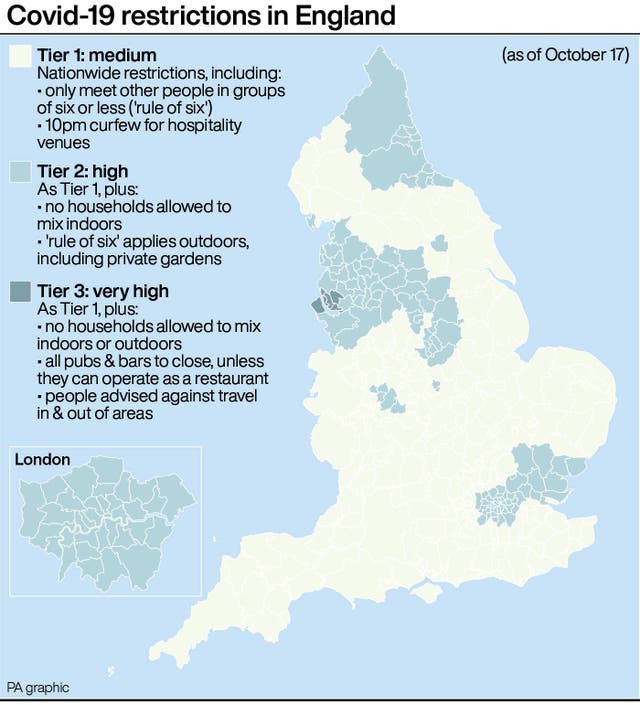
Richard Spurr 1am - 4am
15 October 2020, 13:44

But a row between local leaders and Whitehall means Greater Manchester has not yet seen the harshest level of restrictions imposed.
Millions more people in London and across England will face tougher coronavirus restrictions from Saturday.
The capital, along with Essex, Elmbridge, Barrow-in-Furness, York, North East Derbyshire, Erewash and Chesterfield will move into the second tier of measures – including a ban on households mixing indoors, including pubs and restaurants.
But a bitter political row has so far prevented Greater Manchester being moved into Tier 3, with Health Secretary Matt Hancock telling MPs he wanted to see “rapid progress” on the issue.
Mr Hancock’s announcement means that more than half of England’s population will be under Tier 2 “high” alert or Tier 3 “very high” restrictions.
A call between Greater Manchester leaders and Downing Street officials failed to reach an agreement on new restrictions and there will be further meetings later today.
Greater Manchester Mayor Andy Burnham has been resisting following the Liverpool City Region into Tier 3 restrictions, which include the closure of pubs and bars unless they can operate as restaurants.

Mr Hancock told MPs: “Let us be under no illusions about the danger posed by this virus.
“Coronavirus is deadly and it is now spreading exponentially in the UK.”
The new tiered system only came into effect on Wednesday and the decision to re-categorise areas so soon is an indication of growing concerns about the speed at which the virus is again spreading.
Liverpool City Region, comprising 1.6 million people, remains the only area currently in Tier 3.
A further 26.7 million people will now be covered by the Tier 2 restrictions.
The Health Secretary said: “We must take firm and balanced decisions to keep this virus under control.
“This is the only way to protect lives and livelihoods – and we must act now.
“Delayed action means more deaths from Covid, it means more non-Covid deaths and it means more economic pain later.”
London Mayor Sadiq Khan told City Hall the move to Tier 2 is based on “expert public health and scientific advice about what is necessary to save lives in the capital” but stressed that he was pushing for extra support from the Government.
“Nobody wants to see more restrictions – but this is deemed to be necessary in order to protect Londoners’ lives by myself, London council leaders and by ministers,” he said.
The ban on households mixing indoors could be devastating for the capital’s 3,640 pubs and 7,556 restaurants, which will see business suffer but will not be eligible for Government support available to premises which have been ordered to close.
Tory MP Nickie Aiken, who represents the Cities of London and Westminster, said: “Whilst I appreciate the public health crisis we find ourselves in, I remain deeply concerned about the impact further lockdown will have on the capital’s hospitality, leisure and retail businesses.”
As the latest restrictions were announced, the troubled NHS Test and Trace system recorded its worst ever week for contact tracing.
Data shows 62.6% of close contacts of people who tested positive for Covid-19 in England were reached through the system in the week ending October 7.
This is the lowest weekly percentage since Test and Trace began, and is down from 69.5% the previous week.
Meanwhile, Northern Ireland is braced for the toughest controls in the UK so far with pubs and restaurants set to close for four weeks from Friday and schools facing a two-week shutdown.
And the UK Government described a decision by the Welsh Government to ban travel to the country from other parts of the UK with high levels of coronavirus infection as “disappointing”.
Meanwhile, the Government’s former homelessness adviser Dame Louise Casey warned the offer of two-thirds of pay for workers whose employers close would not “cut it”.
Under the furlough scheme, the Government paid 80% of workers’ wages until August, with the scheme winding down until it is fully closed at the end of this month.
A separate Job Support Scheme, which launches on November 1 and lasts for six months, will involve the Government paying two-thirds of each employee’s salary – up to a maximum of £2,100 a month – if their employer is legally required to close their premises because of restrictions.

Dame Louise told the BBC: “It’s like you’re saying to people, ‘You can only afford two-thirds of your rent, you can only afford two-thirds of the food that you need to put on the table’.”
Shadow Treasury chief secretary Bridget Phillipson said: “People shouldn’t have to worry about meeting their rent, paying the bills or putting food on the table because the Government has lost control of the virus.”
But a Treasury spokesman claimed Dame Louise’s comments are “misleading”, adding “the Job Support Scheme is generous by international standards”.
He added: “More importantly, the scheme is specifically designed to support lower earners because they benefit not only from being paid two-thirds of their salary while not working, but also have some of the remaining drop in earnings covered by the welfare system.
“This includes housing costs, with over £9 billion overall being provided in additional support.”